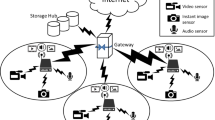Abstract
One of the well-known methods for evaluating Heterogeneous wireless multimedia sensor networks (HWMSNs) in Internet of Things have drawn attention of the research community because this type of networks possesses great advantages of both coverage and performance. One of the most fundamental issues in HWMSNs is the barrier coverage problem which evaluates the surveillance capability of the network systems, especially those designed for security purposes. Among multiple approaches to solve this issue, finding the minimal exposure path (MEP), which corresponds to the worst-case coverage of the network is the most popular and efficient way. However, the MEP problem in HWMSNs (hereinafter heterogeneous multimedia MEP or HM-MEP) is specifically complex and challenging with the unique features of the HWMSNs. Thus, the problem is then converted into numerical functional extreme with high dimension, non-differential and non-linearity. Adapting to these features, two efficient meta-heuristic algorithms, Hybrid Evolutionary Algorithm (HEA) and Gravitation Particle Swarm Optimization (GPSO) are proposed for solving the problem. The HEA is a hybrid evolutionary algorithm in combination with local search while the GPSO is a novel particle swarm optimization based on the gravity force theory. Experimental results on extensive instances indicate that the proposed algorithms are suitable for the HM-MEP problem and perform well in term of both solution accuracy and computation time compared to existing approaches.















Similar content being viewed by others
References
Adriaens J, Megerian S, Potkonjak M (2006) Optimal worst-case coverage of directional field-of-view sensor networks. SECON pp 336–345
Ai J, Abouzeid AA (2006) Coverage by directional sensors in randomly deployed wireless sensor networks. J Comb Optim 11(1):21–41
Akyildiz IF, Melodia T, Chowdhury KR (2007) A survey on wireless multimedia sensor networks. Comput Netw 51(4):921–960
Arfken G, Weber HJ, Harris F (2013) Mathematical methods for physicists, 7th edn. Acadamic Press, Orlando
Binh HTT, Binh NTM, Hoang NH, Tu PA (2016) Heuristic algorithm for finding maximal breach path in wireless sensor network with omnidirectional sensors. In: Humanitarian technology conference (IEEE R10-HTC), pp 1–6
Binh HTT, Binh NTM, Ngoc NH, Ly DTH, Nghia ND (2018) Efficient approximation approaches to minimal exposure path problem in probabilistic coverage model for wireless sensor networks. Appl Soft Comput 76:726–743
Binh NTM, Thang CM, Nghia ND, Binh HTT (2017) Genetic algorithm for solving minimal exposure path problem in mobile sensor networks. IEEE Symposium Series on Computational Intelligence (SSCI), pp 1–8
Clouqueur T, Phipatanasuphorn V, Ramanathan P, Saluja KK (2003) Sensor deployment strategy for detection of targets traversing a region. Mobile Netw Appl 8(4):453–461
Costal D, Guedes LA (2010) The coverage problem in video-based wireless sensor networks: A survey. Sensors 10(9):8215–8247
Djidjev HN (2010) Approximation algorithms for computing minimum exposure paths in a sensor field. ACM Trans Sensor Netw (TOSN) 7(3):23
Guvensan MA, Yavuz AG (2011) On coverage issues in directional sensor networks: A survey. Ad Hoc Netw 9(7):1238–1255
Liu L, Song Y, Zhang H, Ma H, Vasilakos AV (2015) Physarum optimization: A biology-inspired algorithm for the steiner tree problem in networks. IEEE Trans Comput 64(3):818–831
Liu L, Zhang X, Ma H (2013) Percolation theory-based exposure-path prevention for wireless sensor networks coverage in internet of things. IEEE Sensors J 13(1—10):3625–3636
Liu L, Zhang X, Ma H (2014) Minimal exposure path algorithms for directional sensor networks. Wirel Commun Mob Comput 14(1—10):979–994
Luigi A, Iera A, Morabi G (2010) The internet of things: A survey. Comput Netw 54(15):2787–2805
Ma H, Liu Y (2005) On coverage problems of directional sensor networks. International Conference on Mobile Ad-Hoc and Sensor Networks, pp 721–731
Ma H, Liu Y (2007) Some problems of directional sensor networks. Int J Sensor Netw 2(1–2):44–52
Megerian S, Koushanfar F, Potkonjak M, Srivastava M (2003) Minimal and maximal exposure path algorithms for wireless embedded sensor networks. Proceedings of the 1st international conference on Embedded networked sensor systems. ACM, pp 40–50
Megerian S, Koushanfar F, Potkonjak M, Srivastava M (2005) Worst and best-case coverage in sensor networks. IEEE Trans Mobile Comput 4(1):84–92
Meguerdichian S, Koushanfar F, Potkonjak M, Srivastava MB (2001) Coverage problems in wireless ad-hoc sensor networks. In: Proc IEEE Infocom pp 1380–1387
Meguerdichian S, Koushanfar F, Qu G (2001) Exposure in wireless ad-hoc sensor networks. ACM, Proceedings of the 7th annual international conference on Mobile computing and networking, pp 139–150
Miao Y, Wang Y, Jing–Xuan W (2015) Hybrid particle swarm algorithm for minimum exposure path problem in heterogeneous wireless sensor network. Int J Wirel Mob Comput 8(1):74–81
Nakisa B, Rastgoo MN (2014) A survey: Particle swarm optimization based algorithms to solve premature convergence problem. J Comput Sci 10(9):1758–1765
Rashedi E, Nezamabadi-pour H, Saryazdi S (2009) Gsa: A gravitational search algorithm. Inform Sci 179(13):2232–2248
Schutz B (2003) Gravity from the ground up. Cambridge University Press, Cambridge
Song Y, Liu L, Ma H, Vasilakos AV (2014) A biology-based algorithm to minimal exposure problem of wireless sensor networks. IEEE Trans Netw Service Manag 11(1—3):417– 430
Sun Y, Luo H, Das SK (2012) A trust-based framework for fault-tolerant data aggregation in wireless multimedia sensor networks. IEEE Trans Dependable Secure Comput 9(6): 785–797
Veltri G, Huang Q, Qu G, Potkonjak M (2002) Exposure in wireless sensor networks: theory and practical solutions. Wirel Netw 8(5):443–454
Wang B (2011) Coverage problems in sensor networks: A survey. ACM Comput Surveys (CSUR) 43(1-12):32
Ye M, Wang Y, Dai C, Wang X (2016) A hybrid genetic algorithm for the minimum exposure path problem of wireless sensor networks based on a numerical functional extreme model. IEEE Trans Veh Technol 65 (1—10):8644–8657
Acknowledgements
This research is funded by Vietnam National Foundation for Science and Technology Development (NAFOSTED) under grant number 102.02-2017.316.
Author information
Authors and Affiliations
Corresponding author
Additional information
Publisher’s note
Springer Nature remains neutral with regard to jurisdictional claims in published maps and institutional affiliations.
Rights and permissions
About this article
Cite this article
Binh, N.T.M., Binh, H.T.T., Van Linh, N. et al. Efficient meta-heuristic approaches in solving minimal exposure path problem for heterogeneous wireless multimedia sensor networks in internet of things. Appl Intell 50, 1889–1907 (2020). https://doi.org/10.1007/s10489-019-01628-9
Published:
Issue Date:
DOI: https://doi.org/10.1007/s10489-019-01628-9




